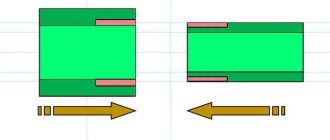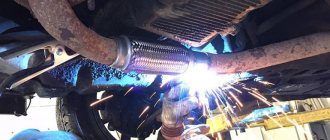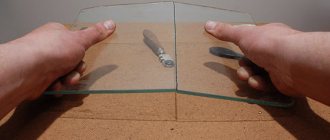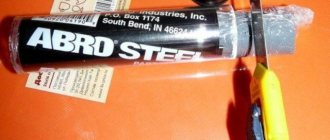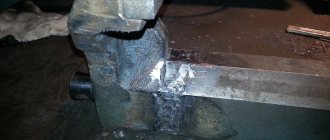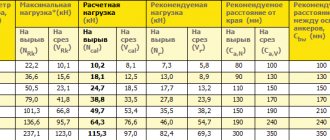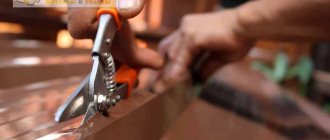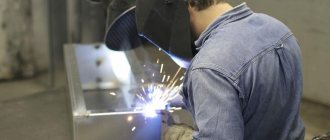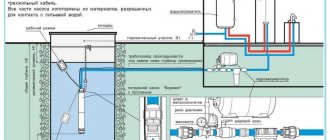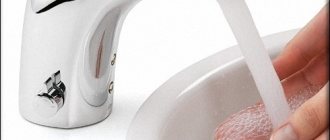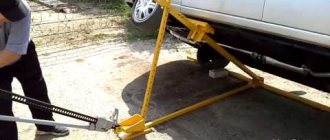How to weld a cast iron engine block
Massive cylinder housings are made from cast iron. This durable material has one significant drawback - it is very fragile.
When struck, cracks form on it or the wall is completely destroyed. Due to small defects, service stations often suggest replacing the engine, although cracks can be effectively eliminated by welding ICE (internal combustion engine) blocks. Is it possible to repair a cast-iron engine block yourself, and how to do it correctly, professionals tell us. They have proven in practice that in a garage, having a welding machine and working skills, it is possible to restore the tightness of the metal and its operating parameters. This engine has been in use for many years.
Welding process
In the previous paragraph, we discussed the preliminary preparation, and before starting welding, we need to consider the main technological points:
- Connection polarity is reverse;
- The power of the welding machine is minimal for a given electrode thickness;
- The length of one continuous weld should not exceed 30 - 50 mm;
- It is necessary to prevent overheating of the metal due to frequent breaks;
- The first and last layers of multilayers are hammered with minimal force.
The table below will help you decide on the welding mode:
We have considered the main preliminary points, but the main question remains: “How to cook cast iron using electric welding?” There are two ways: on studs or in layers. Let's look at each option separately.
Welding cast iron using an inverter using studs
After installing the studs, you can begin welding the seam. Metal is placed layer by layer around each pin to form a patch. You can prevent heating above 80 degrees by doing the work in a checkerboard pattern or alternately at opposite ends. The final point in this type of welding is the connecting seam, which connects the welded metal between the studs.
Multilayer welding
First you need to make sure that the chamfers are created correctly. Then, using a special electrode, observing the temperature regime, we begin to fuse the first layer. It is fundamental and will determine the success of further work. Each layer, while still hot, must be hammered. If there is access to the back side of the part, then after the first layer on one side you should turn the product over and fuse a similar seam on its back side and only then proceed to complete the multilayer welding of the upper and then the lower part.
Surfacing must be done from the edges, and many layers must be gradually created. The main thing is not to forget to forge each layer. If you don’t know how to check the temperature of a part, then use the random technique. It consists in forming a seam alternately at different joints. When the weld is completely ready, the surface deposited on the cast iron must be ground.
If you are faced with the need to weld cast iron and you only have an inverter, then at home you can repair cracks or apply patches to non-load-bearing structural elements. You will already have almost everything you need, such as a mask, protective gloves and clothing. You will only have to purchase special cast iron electrodes, or make them yourself. This article describes two ways to weld cast iron at home. Which one suits you best – decide for yourself. But remember - when there is a need to restore a product that requires heavy loads, it is better to turn to professionals.
Methods for welding a cast iron cylinder block
To reliably eliminate small defects in the form of cracks, there are several effective methods. Difficulties arise when repairing aluminum alloys. This is due to a change in the properties of the metal when heated, the formation of a refractory oxide film. The aluminum engine block requires some gas welding skills. If cracks appear in cast iron, welding of the cast iron block is carried out in three ways:
- when heating everything;
- fragmentary heating of the repaired area, used when it is impossible to completely heat the overall body;
- electric welding on a cold surface, this method is most popular due to the ease of execution and the quality of sealing cracks.
Hot welding
According to the technology, the part to be welded must be heated to +600-700°C, this is done in special furnaces and furnaces. Craftsmen carry out the process in casings with an asbestos layer. Gas burners are used for this. When heated, the metal retains its plasticity and viscosity. It is better welded by the electric arc liquid bath method using electrodes of the MNCh-2, OMCh-1, OMCh-2, OZCh-2, OZZHN-1, TsCh-4 brands.
The method is used to seal cracks in hard-to-reach places. Special holes are made in the casing to seal defects. Heating is carried out slowly, since a sharp temperature change deteriorates the quality of cast iron.
Cold welding without preheating the block
The process of eliminating cracks is carried out using three methods:
- electric arc using flux, cast iron filler rods, graphite or carbon electrodes;
- manually using a protective atmosphere (argon), the electrode must contain graphitizers that reduce the fragility of the weld;
- semi-automatic with flux-cored filler wire in a carbon dioxide atmosphere. The cold method of metal repair is more economical; it involves heating the area in the weld area to a temperature of + 80°C.
Features of welding engine blocks made of cast iron
There are many methods for welding metals, but in order to obtain the most reliable connection of individual parts, it is necessary to use proven technologies that can guarantee the effective performance of welding work.
Welding technology
Regardless of the conditions under which a cast iron cylinder block is welded, it is necessary to strictly follow the following requirements for performing this type of work:
Cracked car engine block
There are three options for welding cracks in cast iron cylinder blocks:
If, after welding the crack, the surface of the cylinder block comes into contact with other engine parts during operation, it is subject to additional processing. Excess welding metal is removed using sandpaper, a file, or an abrasive.
Hot welding
Heating of the entire engine structural element is carried out during welding using oxygen and acetylene. The connection is made by forming an electric arc using steel or cast iron electrodes with a special coating. The product is slowly heated to 600–650 degrees, for which a steel casing with an asbestos gasket is used. This technique is used to weld cracks in hard-to-reach areas of the part.
Important! Only an experienced welder can weld a cast-iron car engine block properly. Unprofessional work can lead to complete failure of this part.
Source
Welding technology
Now let's talk in detail about how to weld a crack with your own hands. Parts are pressed out at the site of damage. The defect is discovered after hydrotesting; for convenience, the crack is marked with a thick chalk solution. 5 mm holes are drilled at the ends.
To weld a cast iron block you will need:
- welding machine with current regulator or inverter;
- 2–3 electrodes, it is better to purchase universal Zeller 855;
- chamfering tool;
- brush and hammer for cleaning the seam and removing scale.
The crack must be welded using the following technology:
- The seam area is cleaned to a shine and degreased.
- Flux is applied to both sides of the edges, protecting the cast iron from heating.
- The repair area is heated by a gas burner evenly and gradually, the direction of movement is along the crack.
- The seam is formed in small sections, up to 15 cm long per pass.
- The resulting seam is heated for about five minutes so that the metal cools slowly. When subjected to sudden cooling, it will become brittle and will not withstand the workload.
- The scale is carefully knocked off, and after a visual inspection the joint is well cleaned, especially if the chip is in contact with other parts.
By forging each roller separately, you can immediately eliminate possible defects.
When a defect is found on the engine block, do not rush to replace it. It is better to consult with specialists whether it makes sense to undertake repairs. It is possible to weld a block crack with cold metal in a garage. You need at least basic welding skills to get the job done accurately. Some service stations provide welding services for internal combustion engine blocks; this is much more expedient and cheaper than completely replacing the engine.
The need to weld the cylinder block arises when cracks appear on it. A large number of blocks are made by casting cast iron. Cast iron is a fairly strong and hard material, lends itself well to casting and has a low melting point compared to steel. The negative side of the material is fragility and low viscosity. In this regard, the most common malfunction of blocks is the appearance of cracks.
Rice. 1. Cylinder block
Features of cast iron
Cast iron is an unusual material; despite its superior melting properties, it is highly susceptible to sudden impacts that can occur in accidents.
Since the engine block contains many different holes for fastening other parts and the channels of the cooling jacket leak, cracks can also occur when the liquid used to reduce the temperature during work processes freezes. Cast iron has high levels of rigidity and strength, and low production costs. Cast iron is smelted from ore at a lower temperature compared to steel and has excellent fluidity, which reduces the cost of manufacturing structures that require strength and have production volumes that affect the entire economy of the state.
Preparing the cylinder block for welding
Before carrying out welding work to repair the unit, it is necessary to thoroughly clean it of dirt, oil and other contaminants. Cracks and discontinuities identified on the block must be marked with chalk or other convenient means.
In order to avoid the growth of cracks, its edges must be drilled. Small cracks up to 5 mm can be welded without cutting the edges. Deeper cracks must be made with cutting edges.
Rice. 2. Drilling cracks
The hole must not be made through, but only until a gap appears along the entire length of the crack. The crack prepared for welding should resemble a joint with a V-shaped bevel of the edges. This is done so that during welding all gases and impurities contained in the welding materials and base metal can escape to the surface of the weld.
Preparing parts
Before proceeding to welding, the parts must be cleaned to a shine. This is done with manual or mechanical brushes with steel bristles.
The edges of the crack or the parts being joined are cut by chamfering at an angle of 40-45 degrees, to a depth of 0.5-0.7 of their thickness. Cracks are cut to the full depth for complete penetration.
The edges to be joined should not be sharp. Cavities and shells are drilled out to the full depth of the damage.
To prevent further crack propagation, eliminate stress points as follows.
From the place where the fault ends, 6-7 mm are retreated in the direction of its development and a through hole is drilled. A drill is used with a diameter of about 4 mm.
Video on welding cast iron cylinder blocks using the argon arc method
In the next video, the author welds a crack on a block using the argon arc method with a non-consumable electrode.
How can you weld or solder a cast-iron engine block?) It may seem funny, but some people say that it’s possible, some tricks the Chinese are selling that can be soldered. But I would like to know your opinion and advice?
Such a thing, on the engine block where the bend of the joint with the oil pan is cracked, oil is leaking from there.
The crack is due to the fact that the previous owner, when removing the pallet, hit it past with a hammer, the mark of the chisel is clearly visible)))
We tried it with sealant, it’s enough for about 3-4 thousand. I’m afraid that this crack won’t go any further.
GAZ-52 engine cylinder block: Hole in the main oil line.
Technical requirements: the tightness of the channel at the site of the hole must be ensured.
A small hole in the oil channel (with an area of less than 100 mm2) is welded using electric arc welding with an OZCH-6 electrode. Before this, a graphite rod with a diameter 0.5 mm smaller than the oil channel is inserted into the hole opposite the hole. This prevents molten metal from flowing into the channel and eliminates the need for additional drilling operations. After welding the hole, the graphite rod is knocked out.
A small hole can also be repaired with an epoxy composition. To prevent the composition from flowing into the channel, a wooden plug wrapped in paper is inserted opposite the hole. To increase the strength of the connection, the epoxy composition is reinforced with two or three layers of fiberglass. The thickness of the epoxy composition layer should be the same as the channel wall itself. After the composition has cured, the wooden pin is knocked out and the channel is cleaned with a brush.
The cylinder block, in which the hole exceeds 100 mm2, is restored as follows. First, a steel or aluminum tube is hammered into the oil channel, having an outer diameter 0.1 mm smaller than the channel opening and a wall thickness of no more than 1 mm. The ends of the tube should completely cover the hole. After this, the hole above the tube is filled with an epoxy composition, giving the surface its original shape.
After the epoxy composition has cured, the oil channel must be tested for leaks with kerosene. To do this, close all the holes in the channel, leaving one for filling with kerosene, apply a layer of chalk on the side of the crankcase or block on the outside of the hole, after which the channel is filled with kerosene. If there are even the slightest leaks in the channel, traces of kerosene will appear on the chalk surface.
Other related articles:
- Restoration of parts using epoxy compositions and stone paste
- Examples of restoration of parts by surfacing
- Examples of restoration of parts made of aluminum alloys
- Technological methods of the repair production process
- Restoration of parts made of aluminum alloys using epoxy compositions
- Mains switch - anti-theft device
- Methods for restoring parts
- High voltage wires
- Galvanic repair coatings
- Restoring car parts
Welding an engine block with argon - does it make sense?
There are different types of car engine repairs. You can simply use recovery after the breakdown of some internal and peripheral parts. And it is possible to restore after serious damage. These types of breakdowns include cracks in the cylinder block, chips in functional areas of the unit and various other features. With such breakdowns, it is simply impossible to operate the power unit, otherwise it may rupture during the process of pressurizing the chambers. There are two options for getting out of the situation. The first is replacing the damaged part. You need to select a suitable version of the engine block or a specific part; this can be done by disassembling, but with the help of a good specialist. This way you can make a really high-quality selection and buy reliable spare parts for restoration.
The second option is argon welding. Many owners of cars with damaged power units perform argon welding. This is a fairly high-quality process of connecting aluminum alloy parts to each other. However, this is not the best solution for load-bearing main engine parts. If the cylinder block is cracked, it is better to buy a new one. Here welding will not be an appropriate solution to the problem. This is one of the most expensive options for car breakdowns, but sometimes you can get by with more or less affordable costs. It all depends on the type and location of the crack, as well as a number of other features. It is important to complete all tasks really efficiently in order to restore all parts and obtain high reliability of the power unit.
How to repair a crack in a cylinder block
Depending on the extent of the damage, various methods can be used to repair the cylinder block. It is worth noting that in some cases it is more advisable to replace the unit rather than repair it.
Welding method
The most common method of repairing a crack in a cylinder block. At the same time, welding a cylinder block is quite a complex job, since it requires strict adherence to technological regulations. If you make mistakes when welding, the seam will come apart while the engine is running and the problem will return.
When welding, the ends of the crack on the cylinder block are initially drilled out. This must be done to avoid the possibility of crack propagation. Drilling and further grinding are carried out at an angle of 90 degrees.
Next, the welding process itself begins. To do this, the cylinder block must be heated to 650 degrees Celsius, after which a continuous seam is applied using a cast-iron-copper rod and flux. Next, the part is gradually cooled in a heating cabinet.
Important: Do not suddenly cool the part, otherwise it will lead to rupture of the seam. It is worth noting that it is possible to weld the cylinder block without heating it
To do this, you should use electric welding and copper electrodes in a tin wrapper. At the end of the work, the applied seam must be degreased using acetone or special compounds. Next, you need to apply a layer of epoxy paste on top of the seam with a spatula. Next, the part needs to be “dried” by leaving it at room temperature for 24 hours so that the epoxy is completely dry. The final stage is grinding the treated seam
It is worth noting that you can weld the cylinder block without heating it. To do this, you should use electric welding and copper electrodes in a tin wrapper. At the end of the work, the applied seam must be degreased using acetone or special compounds. Next, you need to apply a layer of epoxy paste on top of the seam with a spatula. Next, the part needs to be “dried” by leaving it at room temperature for 24 hours so that the epoxy is completely dry. The final stage is grinding the treated seam.
By applying epoxy and fiberglass method
A simple method that allows you to eliminate minor cracks on the surface of the cylinder block. The method involves creating an additional layer made of epoxy paste and fiberglass on the surface of the crack.
To seal a crack using this method, you first need to thoroughly degrease the surface so that the applied compounds “take root” better. Next, several layers of epoxy paste and several layers of fiberglass are applied alternately. The last layer should be epoxy.
SEAL-LOCK method
A rather labor-intensive modern method of eliminating cracks in a cylinder block. Its clear advantage is the ability to carry out work without welding and without dismantling the engine itself. The essence of the method is to fill existing cracks with soft metal.
The work is performed as follows:
- The first step is to localize the damage. The crack is drilled from the edges;
- After this, holes are drilled across the crack at the pitch provided by the technology. Clip ties are placed in these holes to tie the edges of the crack. Staples should be selected based on the type of split. Service stations usually stock the most common staples in length and shape, and if necessary, they can be custom-made for a specific fault;
- A hole is drilled between the installed brackets and a tapered thread is cut using a special tap;
- To remove the oxide film, the resulting hole is processed;
- The cone plug is screwed into the formed threaded hole;
- Next you need to file down the “extra” part of the plug, which rises above the surface area of the cylinder block. Afterwards, be sure to “tighten” the plug more tightly using special tools, as a result of which the sawed area will break off;
- Next, you need to sand down the protruding remains of the plug;
- After this, they proceed to drilling the next hole, which should partially overlap the previous hole with the plug installed. In this way, the entire crack is filled with plugs;
- After finishing the work, the seam formed by these plugs must be additionally compressed so that it more reliably fixes the gap.
Unlike the repair method by welding a seam, the SEAL-LOCK method allows you to obtain a more reliable seam that is not susceptible to temperature changes.
(128 votes, average: 4.47 out of 5)
Replacing the cylinder block and abandoning welding is the right decision
Any welding, even by the most professional performer, will not be as high quality as installing a new cylinder block. When there is a crack in this unit, the component parts of the unit quickly break down and everything fails. Even with professional welding, it is impossible to maintain all factory dimensions down to the last micron. The cylinder block is replaced as follows:
- Based on the make and model of the engine, the specialist searches for spare parts, selects all peripheral parts that will also have to be changed, and forms a budget;
- Also added to this budget is the cost of work, which each master evaluates in his own way, but it is better to contact a professional car service station;
- Next, the engine is disassembled, the problem and its effect on all other parts, such as pistons, connecting rods, rings and seals in the unit, are studied;
- a new cylinder block is installed, the necessary parts are assembled in the right place, and at each stage several checks are performed, which proves the quality of the part;
- After assembly, it is necessary to diagnose the power unit in different planes, then test drive the car with an understanding of all extraneous sounds and noises in the engine.
If a used cylinder block is being installed, special care must be taken during the engine testing and inspection processes. However, with professional selection of the part, no negative features of the operation of the power unit should arise. That is why replacement is the optimal process for such a breakdown. But welding is not always suitable, even if done professionally.
Preparing cast iron for cold welding with an inverter
Before welding cast iron, it must be prepared. First, the desired area is cleaned with a grinder with a flap wheel or other suitable attachment. After stripping the top layer to non-oxidized metal, it is necessary to carry out mandatory degreasing with gasoline or any other solvent. If you decide to repair the crack, then you need to clear the metal until it ends, and drill a hole with a diameter of 10 mm in this place.
It is worth talking separately about the following preparation features:
1. Hairpins. Arc welding of cast iron can be carried out either layer by layer without the use of supporting elements, or using studs. The studs are made of steel. Their dimensions are strictly regulated, for example, the diameter should not exceed 40% of the thickness of the cast iron. The protrusion of the stud above the metal is limited to 4-6 mm, and the distance between the studs should not be more than 6 diameters. The amount depends only on the size of the connection, but not more than 25% of the fracture area
2. Cutting edges.
Note! The edges should not have a sharp cut at the junction of two parts of metal; the optimal shape is spherical.
3. Electrodes must be special. It is almost impossible to weld such metal with conventional electrodes on steel, so it is worth purchasing an electrode with the addition of copper, chromium, nickel and other alloys that facilitate welding onto fastidious cast iron.
Modern technologies for welding aluminum with argon
There are many processes in a modern car that can be performed using argon. It is quite easy to restore wheels made of light alloy materials using this technology. But the basis is the repair of engine housings and blocks, as well as gearboxes. In the process of welding engine elements with argon, the following important tasks are performed, which are performed only by specialists:
- research and preparation of each element for welding work, cleaning the surface and searching for additional material if necessary, to seal the hole;
- preparing the site according to safety measures, we are talking about welding at very high temperatures with a certain risk of damage to people and objects around;
- implementation of the welding process itself, with careful supervision of all surrounding parts, very careful execution of the main necessary task;
- the use of additional compounds for surface treatment to avoid its oxidation and other unpleasant processes after all welding work has been completed;
- cleaning the welding site if necessary to obtain a smooth surface that meets the manufacturer’s technological requirements for operation.
Features of the material used for the manufacture of cylinder blocks
Car engine blocks are usually cast from cast iron.
This material is an alloy of iron and carbon, the content of which is 2.14%. This negatively affects the quality of the connection. Main difficulties of the process:
- formation of pores and cracks;
- the appearance of hardened structures during processing, the tool used quickly becomes dull;
- As a result of overheating, the thin material crumbles.
Cast iron may differ in composition:
- gray cast iron is a malleable, high-strength material, easy to process, limited weldability;
- white cast iron is a fairly hard and brittle material that can be ground, but cannot be welded.
When does it not make sense to weld with argon?
Often during the operation of a car, it becomes necessary to change the sensor in the engine housing or spark plugs. It may well turn out that these elements are too tight. In this case, the master or owner may apply excessive force and simply break off a piece of the unit. If this was done at the place where the spark plug was installed, you will have to buy a new block. When attempting to weld, the following processes will occur:
- the technician will restore the damaged area as carefully as possible, but the seat diameter can no longer be made ideal for the candle;
- you can use the option of melting, and then drilling and cutting the required thread, but it is also impossible to maintain the required installation height of the candle;
- if we are talking about a sensor, it is also simply melted and not used in the future, because otherwise you will have to perform incredibly difficult work to restore the installation site;
- if there is a crack in the body itself from the outside, you can be sure that there is a crack on the inside, so it can only be welded in certain situations that a specialist knows about;
- unprofessional argon welding will bring big problems, in this case it is better not to do any work with a broken cylinder block, but simply buy a new one.
Welding with an argon mixture occurs using a tungsten electrode, which heats up to a temperature of about 4000 degrees at maximum mode. This requires not only increased caution, but also fairly high professionalism. Simply place the electrode in the wrong spot, and it will simply make another hole instead of welding the necessary elements of your engine.
Argon arc welding. What is this?
Principle: the electric arc is a source of heating, it is due to it that the metal melts, and argon acts as an inert gas - it is heavier than air, therefore it instantly displaces oxygen from the zone of formation of the weld. Therefore, at the junction there will be no oxygen or impurities in the surrounding air, which ensures a high purity of the process. Cutting off oxygen helps to obtain a strong, uniform seam.
There are several methods: manual non-consumable electrode welding, automatic non-consumable electrode welding and automatic consumable electrode welding. We will talk about manual argon arc welding with a non-consumable electrode, which is also called TIG welding. It is widely used both in the professional sphere and by amateurs. This method has its strengths and weaknesses.
Welding an engine with argon and subsequent sale - we are clogging up the car market
The attitude of Russian people towards the automobile market is simply surprising. Many people sell their cars, realizing that in two days they will have an irreparable problem and will have to replace expensive components and assemblies. It is enough to simply understand how much anger and hatred the buyer will feel towards you, so as not to make such a mistake. If the cylinder block in your car is cracked, you should work around the situation as follows:
- replace the unit with a used, but high-quality one, get more money from the leisurely sale of the car without special discounts and with confidence in the high quality of the car;
- replace the cylinder block with a new one and continue driving the car without selling it, enjoying the fairly high quality of the revived power unit;
- indicate in the sales advertisement that the car is damaged, there are certain problems that can be solved for a certain amount, which will result in a discount;
- when meeting with a potential buyer, honestly tell them that there is a problem with the engine that needs to be solved urgently, and reveal your readiness to concede the selling price;
- weld the engine with argon, and then, when selling, honestly admit this and show the place of welding, this will relieve you of any responsibility for the further behavior of the unit.
It is often possible to gain no more than a few hundred dollars by concealing all the details of car repairs from the buyer. And this amount is definitely not worth it to continue to clog up the automotive market with not entirely suitable equipment. Such decisions can also be disastrous for you if the buyer decides to look into the whole situation. However, for now there is no need to expect a civilized market in Russia. We invite you to look at more or less high-quality restoration of microcracks using argon:
How engines are restored using welding
Welding of various engine elements was in great demand in an era of shortage of spare parts and restrictions on the free replacement of units. However, even today this operation has not lost its significance and is capable of bringing the engine back to life from the other world when, for one reason or another, it needs to be saved.
Serious damage to the cylinder block or its head is not a death sentence for the engine. Yes, on the one hand, it is easier to change the damaged element. Now it’s not a problem to buy, for example, a new short block (cylinder block assembly). But in some cases, the price of such a purchase may be equal to half the current cost of the car itself. Therefore, repairing engine components using welding may be a more profitable option.
Theory and practice
With the help of welding, it is possible to successfully treat cracks, restore the walls between the cylinders, and even seal a hole in the block punched by a connecting rod. In each specific case, only the master himself determines the feasibility of such complex repairs and its cost. The limitation is the location and nature of the damage. In some cases, successful repair is impossible in principle, and in others the cost of the issue is very high.
The specifics of welding depend on the material used to make the parts. It is easiest to work with aluminum alloys - their melting point is low, and the metal flows well. Things are much more complicated with cast iron. To work with it you need higher temperatures and more expensive equipment.
Any welding work involves strong local heating of the part, as a result of which it can “lead” (violation of its geometric dimensions). Therefore, it is very dangerous to carry out such activities on a motor installed on a car, and without final quality checks. The banal welding of some torn bracket with this approach can lead to the fact that the nearest cylinder will move, and the piston in it will generally jam. Professionals very often encounter negative consequences of such welding to varying degrees of severity. Repeated repairs are much more difficult for the master himself and more expensive for the client.
High-quality welding technology involves preheating both aluminum and cast iron parts. Elements made of light alloys are heated to approximately 250ºC, and elements of heavy metal - up to 350–400ºC. More is possible if the equipment and the welder’s patience allow working with a hot part. In this case, the consequences of strong local heating are minimized. After welding, the parts are slowly cooled.
After any type of welding, it is necessary to check the geometry of the parts, for example, the diameters of the cylinder along the entire height and the plane of the mating surfaces of the block or its head, as well as their crimping in a hot water bath. If some elements still fail, then their geometry is restored to factory parameters.
Light alloys
Although aluminum alloys are quite convenient for welding, they also have their own unpleasant features associated with the quality of casting. When working with the same part, there are areas in which the metal melts very well, while in others it foams and a lot of slag and dirt float up. Experts note that this is often not related to a specific automaker.
Welding on alloys is carried out using special aluminum wire. The cracks are excavated to the base and new metal is deposited on top. Large holes are sealed using high-quality aluminum patches.
The cost of work depends on the specific case, because the complexity of their implementation is always different. It is very difficult to determine the average price tag, but rough calculations can be made. Welding a hole in the wall between the cylinders today can cost from 5 thousand rubles, and repair by installing a patch can cost from 7–8 thousand. Welding the entire mating surface to restore its plane for an inline four-cylinder block and its head costs approximately 9 thousand rubles. for every detail.
Let's sum it up
As you can see, the cylinder block is welded with argon most often for sale. This is not the most reliable option for repairing a power plant. But there are masters who can do everything quite efficiently. Often, after a visit to them, the owners decide to sell the car, as they are constantly worried about the presence of handicraft interference in the operation of the engine. Any sound becomes scary, it seems that the engine is now going to shatter into small pieces. Therefore, when repairing a car for your own further use, it is much better and easier to perform a normal repair with replacement of the cylinder block.
When making repairs for sale, it is better to refuse any work altogether, simply discounting the price to the buyer for the amount of repair work. If the new owner wants to cook the engine with argon, that will be his problem. You will come out of this situation fairly honestly with an untarnished reputation. You should not carry out cheap argon welding in a garage car service, and then quickly go to the car market in the hope of selling the car and forgetting about all these problems. Through mutual scams, car owners have already made the car market a dangerous place where they can lose all their money. How do you feel about repairing unit housings and gearboxes using argon welding?
Methods for sealing cracks
Hot welding. Heating of the entire block is used during welding when acetylene and oxygen are used. Welding of the engine block occurs when an electric arc is formed, and electrodes made of cast iron or steel coated with a special compound are used. The part is heated slowly to a temperature of 6-6.5 hundred degrees; for uniform heating, a specially equipped steel casing with an asbestos layer is used.
It will be useful: LED headlights or xenon, which is better?
Holes are cut in the casing in advance to allow access to damaged areas. This method is the most expensive and labor-intensive, but it leads to the restoration of a material that practically corresponds to its initial parameters. This method is used if cracks appear in hard-to-reach places, for example, at the junction of walls of different thicknesses. With this method, the internal stresses of the product that arise during welding practically approach zero.
Welding with local heating. This method is used when damage occurs on a surface whose heating will not cause internal stress in various parts of the entire block. During welding, the surface to be repaired is constantly heated. Heating is carried out with a gas burner up to 6-7 hundred degrees.
At the end of the work, the finished surface is again heated to the specified temperature and left to cool. When using this method, special knowledge and high professionalism of the person performing the work are required, so it is used infrequently. Welding the engine block without heating. This method is used when repairing surfaces located at a distance from areas bearing any load to such a length that the heating occurring during welding and subsequent cooling will not affect their strength.
Such welding can be performed with gas torches, electrodes made of steel, cast iron or non-ferrous metals. Cracks that have arisen in the cooling jacket are best welded in this way, using electrodes made of iron and copper in small sections not exceeding 5 cm. Welding a cast iron cylinder block is a very labor-intensive and scrupulous process, which occurs in several stages, while for Such welding requires special knowledge and skills. The engine block is replete with all sorts of structural channels and mounting holes, around or near which cracks form.
Unprofessional performance of such work can lead to the fact that your block, which you wanted to repair, will simply split or crack in another place.
Cooking cast iron semi-automatically
Cast iron is widely used to make pulleys, blocks, and commutators. It has good casting properties, which makes it possible to produce products of various shapes from it. But this material also has disadvantages - it is quite fragile. Impacts often cause chipping of sides on pulleys or cracks in pipes. To correct the situation and restore the product, they resort to various methods of joining metals. One of them is semi-automatic welding of cast iron. What are the features of this method? How many options are there for using a semi-automatic machine? What supplies are suitable?
Cast iron welding methods
There are three ways to weld cast iron:
- Hot welding. The main and most correct method. It consists in the fact that before working with the electrode, the workpiece is heated to 600 - 650 degrees. This allows you to avoid the formation of compounds with a high melting point, overheating and tension of the metal at the joint. Heating is carried out in ovens, gas or other burners. For home conditions, this method is a stretch, because in addition to the heating device, you need to know at what moments you can work at the welded joint, how to cool the metal and many other nuances.
- Semi-hot welding. It is practically no different from the previous method, with the exception of the heating temperature. Here the product is heated to 300 - 350 degrees.
- Cold welding. The method does not involve heating the workpiece, but it is based on many other technological aspects, failure to comply with which will lead to the impossibility of making a high-quality seam. Welding cast iron at home with an electrode is carried out in this way.
Why is it difficult to cook cast iron?
The question of whether it is possible to cook cast iron with a semi-automatic machine worries many people for good reason. The connection of the sides of this material does have a number of specific features:
- The high fluidity of cast iron manifests itself when forming a seam where the weld pool is too liquid. Because of this, it is more difficult to visually control the quality of compound formation. When trying to weld thin plates of cast iron, a common defect is metal burning and droplets leaking onto the opposite side. To prevent these undesirable manifestations, graphite pads are used to support the plates on the reverse side. You can learn how to form a seam when the metal has high fluidity by practicing on training products made of similar alloys.
- The second difficulty is the low melting point of the material. Due to the high temperature from the electric arc, the cast iron in the welding zone quickly overheats. As a result, upon cooling, microcracks form between the base and superimposed metal. Overheating of additional impurities in cast iron (manganese, silicon) leads to the appearance of cementites in the weld structure, which complicates subsequent processing of the joint with grinding tools. To prevent these defects, they resort to preheating the material and a gradual cooling procedure for the product.
- It is difficult to weld cast iron efficiently due to the large number of pores that appear as a result of the release of carbon when interacting with oxygen. Even with subsequent processing, the seam may have an unattractive appearance and poor resistance to fracture. To protect the connection, copper-plated wire is used, and the work is carried out in an inert gas environment. A prerequisite for welding cast iron is the flux content in the wire.
Weldability of cast iron and other properties
Welding a cast iron engine block using a semi-automatic machine requires compliance with all the processing features of this material. Cast iron is highly saturated with carbon. But when exposed to temperature, it begins to evaporate and reacts with surrounding elements, which forms CO. When this compound gets into the metal, it leads to the appearance of cracks during welding.
Welding a cast iron block
It is also worth noting the property of rapid cooling of the metal. If we allow a sharp drop in temperature, which in this case can happen in a completely natural way, then pores and cracks may form in the metal, not to mention other deformations. During cooling, compounds of different crystal lattice structures are formed in cast iron. Accordingly, all these connections can have different volumes. This can cause internal pores to form.
It is also worth noting the low plastic properties, which leads to the appearance of overstresses in the metal, which also causes cracks to appear. This is especially true when welding thin metal with an electrode. The metal is highly brittle, which creates additional difficulties in processing and creates conditions under which cracks can form even with relatively small mechanical impacts.
Welding methods
Depending on the purpose of the product, three types of semi-automatic welding of cast iron are used. They differ in the speed of work completion and material costs.
Cold method
This is the easiest way to quickly join high carbon iron plates. Welding is performed immediately on a material whose temperature is equal to the ambient temperature. The cold method is used on non-critical butt joints that will not be subject to loads. The method is ideal for surfacing worn surfaces and machine parts made of cast iron. Thanks to the continuous wire feed, you can quickly arc and complete a large amount of work in a short time. As you can see in the video on semi-automatic welding of cast iron, the result from the cold method is satisfactory.
Semi-hot method
The semi-hot welding process differs from the previous one in that the cast iron workpieces are preheated to a temperature of 350 degrees. For this purpose, forges are used, in which the heat from the coals creates the necessary conditions. This preparation contributes to a more gentle reaction of cast iron to the high temperature of the electric arc, resulting in the formation of fewer cracks in the heat-affected zone. The technology is used on products that experience some stress during operation.
Hot method
This method is used where a high-quality connection is needed that has high tear and fracture resistance. The product heats up to a temperature of 600 degrees. For this purpose, devices producing induction currents are used. The cables are connected to the cast iron part, and a special measuring device signals the temperature reached. After this, semi-automatic welding is performed. To minimize cracks, after welding the product is left in the ash until it cools completely. Depending on the thickness of the structure, this period can reach 24 hours. The method allows you to weld cast iron reliably and efficiently, but is characterized by high time costs and the need for additional equipment.
Selection of electrodes for welding
Electrodes used in various types of welding.
Common types of electrodes for welding cast iron (according to Russian standards):
- TsCh-4, designed for welding without heating the structure. They have a diameter of 3, 4 and 5 mm. The composition of the deposited metal includes up to 0.25% carbon, manganese, vanadium and silicon are present. The products have a base coating; surfacing 1 kg of material will require 1.4 kg of electrodes. It is allowed to use DC or AC equipment (reverse connection).
- OZCh-2, having an acid coating. They are designed for sealing cracks and surfacing material on products made of gray or ductile iron. Designed for welding with short beads (length from 30 to 50 mm) with forging immediately after extinguishing the arc and cooling under the influence of atmospheric air. Before work, they require calcination at a temperature of about +200°C for 1 hour. The rod consists of copper with the addition of iron and nickel (10% and 2% respectively), it contains manganese and a small amount of silicon.
- OZZHN-1 with basic coating. They provide a deposited material that matches the shade of gray cast iron. Designed for cold welding with short beads with forging and gradual cooling. Designed for direct current equipment with direct polarity of connection. To seal large faults, such electrodes are used in conjunction with MNC-2. Their rod consists of an alloy of nickel with iron and additives (carbon, manganese, silicon and traces of aluminum).
- MNC-2 are designed to operate without preheating the workpiece. They are used for welding defects in gray cast iron blocks. Provides a weld material with increased hardness. Welding requires DC equipment with reverse polarity.
In addition to Russian brands, there are analogues produced by the Swedish company Esab or the German factories Kjellberg or Zeller. For example, Zeller's 855 electrodes have a bimetallic core (nickel-iron alloy) and a graphite-based base coating. They are designed for welding cast iron without heating the edges (connecting steel elements with a cast iron base is allowed). Initially created for the restoration of crankcases of power units or transmission units.
Equipment and consumables
To obtain good joints from difficult-to-weld alloys, any semi-automatic machines are used. The main criteria are compliance with the maximum current of the device required to penetrate a specific thickness of metal. The adjustable current and wire feed speed parameters are similar to welding conventional steel.
Wire is used with specialized markings: PP ANCH-1, as well as with numbers 2 and 3. Each number is intended for a specific method (cold, semi-hot, hot). The wire has a tubular structure and contains flux powder inside, which protects the weld pool from exposure to oxygen. Enrichment of the applied metal with special impurities promotes high tensile strength of the seam and tensile strength. Thanks to Anch wire, it is possible not only to eliminate minor defects in cast iron, but also to produce full-fledged seams that firmly connect this specific metal.
To weld cast iron, a gas supply is used, which additionally protects the weld pool. Depending on the purpose of the product and the amount of impurities in the alloy, you can use carbon dioxide in its pure form or its mixture with argon, where the latter will be 80%. The flow rate from the pressure gauge to the burner should be 6-11 liters. This will optimally protect the molten metal from displacing carbon.
Subtleties of welding various metals
Now that you know about the sequence of the argon arc welding process, you can move on to more specific issues. After all, when working with different types of metals there are nuances. Let's talk about the most common ones.
Table 1
| Workpiece thickness, mm | Diameter of tungsten electrode, mm | Rod diameter, mm | Current strength, A |
| 1 – 2 | 2 | 1 – 2 | 50 – 70 |
| 4 – 6 | 3 | 2 – 3 | 100 – 130 |
| 4 – 6 | 4 | 3 | 160 – 180 |
| 6 – 10 | 5 | 3 – 4 | 220 – 300 |
| 11 – 15 | 6 | 4 | 280 – 360 |
table 2
| Workpiece thickness, mm | Electrode diameter, mm | Wire diameter, mm | Current strength, A |
| 0,3 – 0,7 | 1,6 | – | 40 |
| 0,8 – 1,2 | 1,6 | – | 60 – 80 |
| 1,5 – 2,0 | 2 | 2,0 – 2,5 | 80 – 120 |
| 2,5 – 3,5 | 3 | 2,0 – 2,5 | 150 – 200 |
Table 3
| Type of electrode | Workpiece thickness, mm | Electrode diameter, mm | Current strength, A | Arc length, mm |
| Graphite | 2 | 6 | 125 – 200 | 5 – 8 |
| 5 | 8 | 200 – 350 | 10 – 15 | |
| 8 | 10 | 300 – 450 | 15 – 20 | |
| 13 | 15 | 450 – 700 | 25 – 30 | |
| Coated | 2 | 2 – 3 | 100 – 120 | – |
| 3 | 3 – 4 | 120 – 160 | – | |
| 4 | 4 – 5 | 160 – 200 | – | |
| 5 | 5 – 6 | 240 – 300 | – | |
| 6 | 6 – 7 | 260 – 340 | – | |
| 8 | 7 – 8 | 380 – 400 | – | |
| 10 | 7 – 8 | 400 – 420 | – |
We hope that our article will be useful to you and will help you successfully master argon arc welding. Regular practice and patience will soon yield results. And with high-quality equipment it’s even easier to do this! You can buy a TIG welding machine in our online store. Also with us you will find the necessary equipment and consumables for welding work. Explore the range, compare and place an order on the website or by calling 8-800-333-83-28.
Source
Semi-automatic welding technology
When welding cast iron with a semi-automatic machine, regardless of the temperature conditions, it is necessary to properly prepare the material. If you need to weld a crack, it is important to make a preliminary cut with a grinder along the entire split line. This will allow the filler material to be fused deeper. It is recommended to drill the edges of the cracks to limit its continuation.
If the thickness of the plates is more than 5 mm, then cutting the edges at 45-60 degrees is necessary. When working with thin sheets (up to 3 mm), graphite preforming is used to prevent burns. The first seam is made with a smooth pass without oscillatory movements. The burner can be operated from top to bottom or from right to left, tilted 50 degrees. The distance between the nozzle and the surface is maintained within 6-8 mm. It is important that the welder can see the end of the wire.
It is rarely possible to brew cast iron the first time, so it is recommended to go through the seam in several layers. Subsequent passes can be made with transverse vibrations in order to bind the base and deposit metal more widely. After welding is completed, it is necessary to separate the slag formed during combustion of the flux-cored wire and ensure the quality of the result.
Semi-automatic welding of cast iron is quite popular due to its high productivity and good quality of connections. By choosing the right wire and temperature conditions, you can get a reliable connection on this “capricious” material.
Features of the material
Cast iron is an alloy of carbon and iron, where the carbon content is 2.14%. Which negatively affects the quality of the connection.
The process is labor intensive due to:
- formation of cracks and pores;
- during processing, the appearance of hardened structures and rapid dulling of the tool;
- thin material crumbles from overheating.
According to its composition, cast iron is divided into gray and white:
- White ones cannot be welded due to their fragility and hardness. Suitable for grinding;
- Gray (high strength, malleable) are easy to machine and have limited weldability.
Technology of welding cast iron with electrodes
There are 2 methods of welding cast iron - hot and cold.
Hot also includes semi-hot.
When hot joining, the part is heated to a temperature of 600-700°C, welding is performed and the cast iron product is slowly cooled in the furnace. With a semi-hot connection, the temperature is maintained at 300-400°C.
Hot and semi-hot welding requires additional equipment. In domestic conditions, a cold connection is used.
Edge cutting
Welding cast iron with an electrode at home requires chamfering. There is no need to degrease or clean the parts.
Chamfering is performed:
Note: sharp edges are not allowed. The sharpness is removed with a suitable tool.
How to cold weld cast iron parts
When connecting, do not overheat the heat-affected area (no more than 80°C). Take frequent breaks between passes. Use multi-pass welding.
- first perform surfacing along the edges of the chamfers;
- then gradually filling the seam;
- After each pass, hot forge the roller.
Make rollers 40 mm long, scattered to reduce heating of the part.
How to weld cast iron using electric welding at home. What you will need:
- current source (inverter);
- electrodes 3 mm;
- seam cleaning brush;
- hammer for forging and removing slag;
- cutter or cutter for cutting chamfers;
- shield and gloves.
- first, cutting edges and blunting sharp corners;
- then surfacing along the edges of the chamfers;
- then gradually fill the seam.
Forge each roller hot. Don’t rush, give the part time to cool (heating of the heat-affected zone is no more than 80°C).
After filling the weld, turn the part over and cut the edges on the reverse side. Perform welding as described above. Observing the temperature regime and forging each roller. At the end of the process, grind the deposited surface if desired.
Video:
Cold welding is used to repair batteries, vices, engine cylinder blocks and other structures made of gray cast iron.
Brands of electrodes for welding cast iron
In this article, you can get acquainted with factory electrodes and homemade electrodes for connecting different types of cast iron.
The table below will help you set the current on the device for different diameters of electrode brands:
The current values are indicated for the lower position of the electrode. For a vertical position, the current is reduced by 15-20 A, except for TsCh-2.
In order to save money, home craftsmen have adapted to welding cast iron with a conventional electrode with copper wire. Video below:
Also, copper wire will help in welding cast iron with steel.
Some craftsmen ask how to cook cast iron with a semi-automatic machine? On metalworking forums, experienced welders advise using PUNCH 11 wire. The connection is made with 2-5 cm stitches with forging, without gas protection on straight polarity. Current 90-110 Amperes depending on the thickness of the metal.
How to cut cast iron
Types of cutting are divided into thermal and mechanical. List of tools and methods:
- The grinder is a simple and affordable way. Minus: the cut occurs in a straight line.
- Pipe cutters have proven themselves well when working with pipes.
- Reciprocating saw.
- Electrode.
- Oxy-fuel cutting is a good option. Oxygen flux will improve the quality of cutting cast iron.
- Mobile installations Thermal cutter 2M (weight up to 5 kg).
- Oxygen-lance cutting and plasma.
As you can see, there is plenty to choose from! The grinder is widely used in everyday life.
